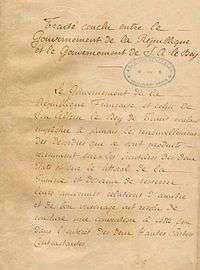Treaty of Bardo

The Treaty of Bardo (or Treaty of Qsar es-S'id, Treaty of Ksar Said) was signed on May 12, 1881 between representatives of the French Republic and Tunisian bey Muhammed as-Sadiq. A raid of Algeria by the Tunisian Kroumer tribe served as a pretext for French armed forces to invade Tunisia. Jules Ferry, the French foreign minister, managed to send a French expeditionary force of approximately 36,000 troops to defeat the Kroumer tribe. The French met little resistance from both the Kroumer tribe and from as-Sadiq. Eventually, the French withdrew their forces after signing the treaty. However, the terms of the agreement gave France responsibility for the defence and foreign policy decisions of Tunisia. The military occupation was stated to be temporary; nevertheless Tunis became a French protectorate.[1]
The treaty was named after the residence of the Tunis court; Le Bardo where the Husainid Beys had established themselves in the early 18th century.
References
- ↑ Stearns, Peter N., ed. (2001). The Encyclopedia of World History: Ancient, Medieval, and Modern, Chronologically Arranged (6 ed.). Houghton Mifflin Harcourt. p. 473. ISBN 0-395-65237-5.
Treaty of Bardo, establishing a French protectorate over Tunis. This went back to the assurances of Salisbury and Bismarck during the Congress of Berlin, but the French government had not acted because of the indifference of French public opinion in matters of colonial expansion and because of distrust of Bismarck's motives. The question was precipitated by the activity of the Italians, determined to make good their failure to secure gains at the Berlin Congress at Austria's expense. The affair initiated a long period of Franco-Italian tension and modified the Mediterranean situation to Britain's disadvantage. Gladstone protested, but the British government was committed by Salisbury's assurances.
Sources
External links
| Wikimedia Commons has media related to Treaty of Bardo. |